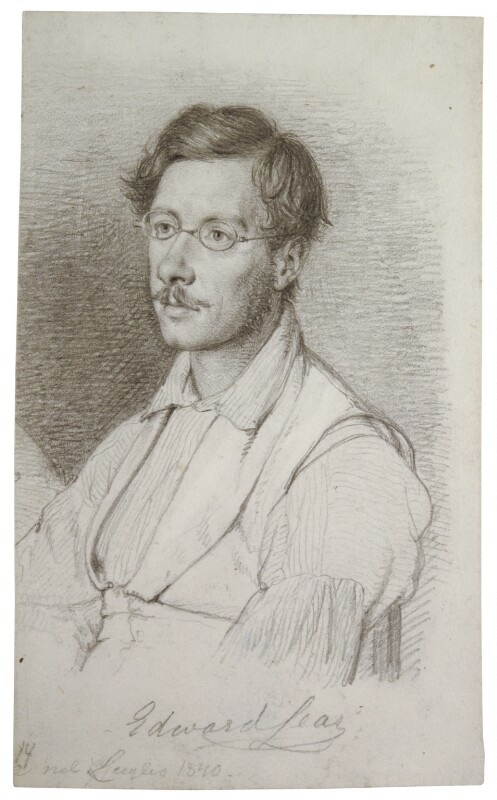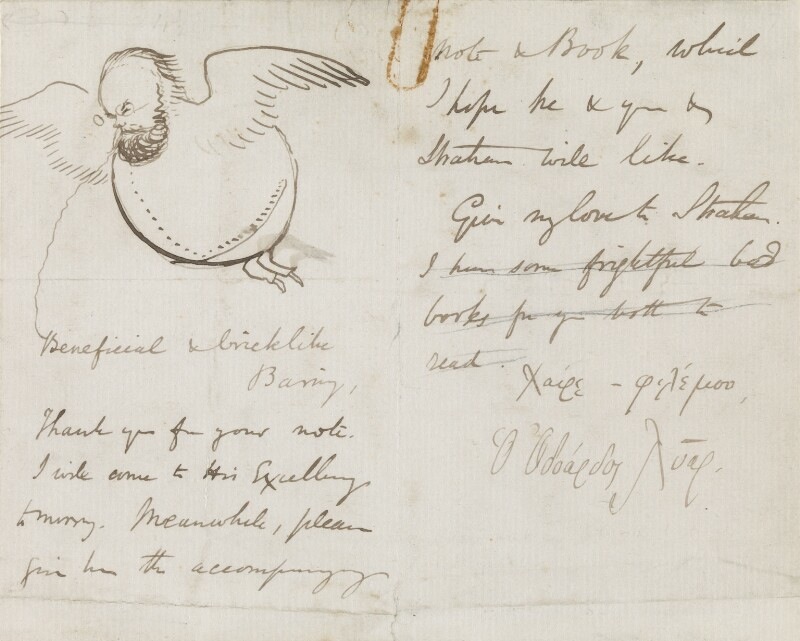This review is reproduced here by kind permission of Professor Bury and the online inter-disciplinary journal Cercles, where the review was first published. The original text has been reformatted and illustrated for the Victorian Web by Jacqueline Banerjee. Thanks to the National Portrait Gallery, London, for permitting use of two of the images used here. Click on all the images to enlarge them.

Cover of the book uder review.
Even though "The Owl and the Pussycat" was elected "Britain's favourite poem" in 2012 (514), and despite their shared passion for nonsense, Edward Lear is far from enjoying the same popularity as his contemporary Lewis Carroll. Both remained lifelong bachelors, both loved to play with language, both were visual artists, but Lear's fame seems much harder to export beyond the borders of the English-speaking world, even though some of his limericks were more or less successfully translated into other languages. Lear never wrote "limericks," by the way, as Jenny Uglow reveals in her new biography: the word only came into common use in 1898, more than ten years after his death (4). Lear called his poems "nonsenses."

Edward Lear, drawn by Wilhelm Nicolai Marstrand in 1840. © National Portrait Gallery, London (NPG 3055).
An experienced biographer of writers (George Eliot, Elizabeth Gaskell) and artists (Hogarth), Uglow has decided to remind us that "There are other Lears" (5) beside the writer of nonsensical poems. Thanks to the very numerous colour illustrations, beautifully printed on thick, smooth paper — a luxury granted by Faber & Faber —, readers can measure the quality of Lear's work as a painter. Contrary to Lewis Carroll, whose drawings for Alice in Wonderland were rejected by his publisher, Lear was a more than skilful draughtsman, and the childish style in which he illustrated his limericks was deliberately crude. Though largely self-taught, Lear emerged from a childhood spent among his variously gifted sisters as a brilliant animal painter. His Illustrations of the Family of Psittacidae, or Parrots, published in 1830-32, caused a sensation and his work was judged "infinitely superior to Audubon" (53). From then on, Lear graduated as a landscape artist, a travel writer, and a nonsensical poet. In order to paint the exotic scenes which found favour with the Victorian public, he spent months, or even years abroad, and was "always eager to fly further" (133): Italy, Greece, Egypt, Palestine.... After a final trip to India in 1873-75, Lear came back to Europe and settled in San Remo, where he died in 1887, aged 75.
The biographer makes much of the analogy between Lear and his favourite type of animals, which probably explains why the front cover of the book is decorated not with a portrait of the writer, but with a splendid watercolour of a green parrot. Even though he managed to be all things to all people, Lear apparently felt a strong proximity with birds. He liked to quote one of the Psalms of David: "I am like a pelican of the wilderness, I am like an owl of the desert" (231). The analogy is here exploited in the very division of the volume into seven parts which are given avian titles: "Fledging," "Perching," "Flying," "Tumbling," "Circling," "Calling" and "Swooping." A keen observer of the human menagerie, Lear sometimes found it hard to enjoy peaceful relations with his fellow men. With his natural gift for fun, he was generally liked by children, but as opposed to Lewis Carroll, "it was the animal side of children he liked, not the 'sacred'" (91). And yet, Jenny Uglow considers "Lear, the man of feeling" and "Lewis Carroll, the man of mind" (305), probably because the latter was a mathematician while the former was primarily an artist.

Lear's pen and ink sketch of himself as a bird, in a note of 1864. © National Portrait Gallery, London (NPG 4351).
Lear's feelings may well be the most controversial aspect of this new biography. It seems at first that twenty-first-century scholars are particularly lucky since diaries and letters have survived: contrary to Carroll, Lear did not have puritanical nieces who applied their censorship to his private papers. However, this assertion has to be qualified, as Lear burnt his own diary in 1840, "giving no reason" (129), not forgetting that his "letters to Frank (Lushington) disappeared and so did Lear's diaries of their time in Corfu" (514). Added to this is the fact that Lear's "fantasies are hidden, even from his diary" (129) and that his "most self-revealing moment" is a sentence in which he deplores the lack of "some communion of heart & spirit — with one who should have been this to me" (245). One may therefore somewhat wonder how Jenny Uglow can be so sure about her subject's true and unexpressed feelings, and be categorical enough to write that "His homosexual longings are clear" (129) or that he "had fallen in love" (197). If Lear is indeed "consistently evasive about his sex life, even in his diary," his biographer's interpretation necessarily has to rely on what remains unsaid — "He doesn't say if he went to brothels, or picked up rent boys — or both" (64). Is it justified to attribute to Lear an interest for the men whom he "hardly mentions" or "never writes" about (129)? Lear may have felt the same anxieties as his friend John Addington Symonds, who did come out of the closet (375-381), but the notion remains hypothetical.
More interestingly, Jenny Uglow also draws as much substance as possible from Lear's poems and drawings. Here again, the reader may feel that too much ingenuity is devoted to the interpretation of some depictions. The book focuses repeatedly on "the sexual innuendo of large noses and pointing limbs" (155), Lear's own obsession with his nose being perceived as "a lasting invitation to phallic readings" (300). Nevertheless, the biographer admits elsewhere that no Victorian reader ever saw those illustrations with such a bias. She also judiciously reminds us that the Victorian age officially started in 1837, and that most of the 1830s were still quite naughty: Lear being born in 1812, the people he met during his youth belonged to a much more relaxed period, the Regency era. Uglow is at her best when she analyses the worldview reflected by the limericks, their opposition between the eccentric individual and the repressive others ("they"). She repeatedly insists on the fact that Lear's fun is "full of melancholy, murder, panic, self-harm and suicide" (160), but the same might be said of Tom and Jerry cartoons or, more historically relevant, of Victorian pantomimes, a point made about Tenniel's illustrations by Frankie Morris in his book Artist of Wonderland (University of Virginia Press, 2005). And it is always a joy to (re)discover Lear's verbal inventiveness, his "gleefully awful rhymes" (96), his "alive, protean, ever evolving" language (266) driven by "the energy and motive power of simple nouns" (268), or his Marypoppinsian adjectives ("splendidophoropherostiphongious" (281)).


Left: Lear's painting, Mount Parnassus, Lake Cephissus, and the Plains of Boetia, exhibited 1852. Right: Illustration from Lear's nonsense poem, "How pleasant to know Mr. Lear" [Click on these images to enlarge them, and for more information].
What remains incontestable is the rich complexity of Lear's personality as "an intelligent, self-aware depressive" (415), the contrast between his painstakingly finished oil paintings, partly influenced by the art of his Pre-Raphaelite friend William Holman Hunt, and some of his "modern, strikingly unconventional" sketches (336) (they do look like Dufy's works, one century later) or the watercolours he produced as illustrations for moods in Tennyson's poetry, "almost abstract in their intensity" (490). Uglow's book helps us go beyond the "cut-out figure," the "semi-cartoon" (134) which Lear created for himself; if "that ferocious hiding of the self" (382) sometimes makes him an elusive subject for a biography, it also brings him closer to our modern sensibilities.
Related Material
- A different review of the same book, by Simon Cooke
- An Introduction to the Life and Works of Edward Lear
Work Cited
Uglow, Jenny. Mr Lear: a Life of Art and Nonsense. Hbk. London: Faber, 2017. 608 pp. ISBN 978-0571269549. £17.00.
Created 15 April 2018